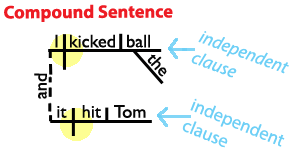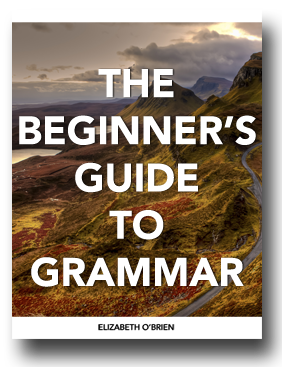Download your free grammar guide here.
Download your free grammar guide here.
Simple Sentences vs. Compound Sentences
Simple Sentences vs. Compound Sentences
- Home
- Sentence Structure
- Compound vs. Simple
If you've studied sentence structure at all, you've read terms like compound sentences and simple sentences.
Today, we'll look at the difference between these two.
Let's get you in the right frame of mind with a tiny quiz.
Are the following sentences simple or compound?
A. Lewis and Alice played in the backyard.
B. Lewis and Alice played and read in the backyard.
C. Lewis played in the backyard, and Alice read in the house.
I'll tell you the answer in a minute. But first...
Simple Sentences: First Things First
Simple sentences are sentences that contain one independent clause and no dependent clauses.
By the way, an independent clause is a group of words that contains a subject and a verb and can stand alone as a complete thought. A dependent clause is also a group of words that contains a subject and a verb, but this kind cannnot stand alone as a complete thought.
I kicked the ball.
It hit Tom.
We're going to use sentence diagrams to help us understand this lesson. Diagrams are pictures of sentences. Here's a diagram of that first sentence. Don't worry about understanding it exactly. There's just one thing I want you to notice.

Look at that main horizontal line with the words I, kicked, and ball. Do you see that there is also a vertical line going through it between I and kicked? Here's a picture with a yellow dot highlighting the part that I'm talking about.

The part that is highlighted - where those two lines cross - lets us know that there is a clause in the diagram. We can tell that this sentence is simple because it contains just one such cross.
Compound Sentences
Sometimes, we want to join simple sentences together to form one sentence. When we join two or more independent clauses into one sentence, we have a compound sentence.
Compound sentences are sentences that contain two or more independent clauses and no dependent clauses.
I kicked the ball, and it hit Tom.
As you might have guessed, we're going to look at another sentence diagram.
How many long horizontal lines with short vertical lines going through them do you see in this diagram? I'll put yellow dots over them again to make them easy to spot, but know that diagrams don't generally have these yellow dots. :)

Do you see that there are two of them? That means that there are two clauses. The diagram makes it easy to see that this compound sentence contains two independent clauses.
Finally! Answers To The Quiz
Compound means that something is made up of more than one part.
As you know, compound sentences are made up of two or more independent clauses and no dependent clauses.
Other parts of sentences can be compound as well.
- Compound subjects are two or more subjects (Bill and Jim ran.)
- Compound verbs are two or more verbs (Bill ran and jumped.).
- Compound direct objects are - you guessed it - two or more direct objects. (I made dinner and breakfast.)
You get the picture. Simple sentences can contain compound elements (such as subjects, verbs, direct objects, etc.) - just not compound clauses. Sentences are only compound when they contain two or more independent clauses (and no dependent clauses).
Let's explore this by going back to the quiz that we started with.
A. Lewis and Alice played in the backyard. --> Simple Sentence
B. Lewis and Alice played in the backyard and read in the house. --> Simple Sentence
C. Lewis played in the backyard, and Alice read in the house. --> Compound Sentence
Sentence C is the only compound sentence. Why? It's the only sentence that has two independent clauses. Notice that it's the only sentence that we can break up into two simple sentences. (Lewis played in the backyard. Alice read in the house.)
Sentences A and B are simple because they contain just one independent clause. They do contain compound elements, but the sentences themselves are not compound. Let's look at some diagrams to see this in action.
A. Lewis and Alice played in the backyard. --> Simple Sentence With Compound Subject

Notice that the diagram shows us only one of those cross designs, meaning that there's only one clause in this sentence. This sentence does have a compound subject, and it's easy to see that in the diagram. Both of the subjects (Lewis and Alice) are "using" the verb played. Both of them performed that action. Notice that you can follow the solid lines under Lewis and Alice to the verb played. They are both "sharing" the verb.
B. Lewis and Alice played in the backyard and read in the house. --> Simple Sentence With Compound Subject & Compound Verb

This diagram looks crazy! But, you're now an expert at finding the cross part in the diagram. You can see here that there is only of these designs. That's because there is only one clause in this sentence!
Like the sentence above, this sentence has a compound subject. It also has a compound verb! Here, both subjects (Lewis and Alice) are performing both of the verbs (played and read). Notice that you can follow the solid lines under Lewis and Alice to both of the verbs. Both subjects are "sharing" both verbs!
In order to be compound, the two subjects and verbs can't "share" each other.
C. Lewis played in the backyard, and Alice read in the house. --> Compound Sentence

Finally! We have a compound sentence. Notice that this sentence diagram contains two dots. That means it contains two clauses. Also notice that, unlike the other diagrams, the subjects of the two sentences each have their own verb. They're not "sharing" the verb here. Lewis played, but he didn't read. Alice read, but she didn't play. Since this sentence has two independent clauses (and no dependent clauses), it is a compound sentence.
If you'd like to teach or learn grammar the easy way—with sentence diagrams—check out our Get Smart Grammar Program.
It starts from the very beginning and teaches you grammar and sentence diagramming in easy, bite-size lessons.
I hope this lesson cleared things up for you!
This is original content from https://www.english-grammar-revolution.com/compound-sentences.html

Hello! I'm Elizabeth O'Brien, and my goal is to get you jazzed about grammar.
Our Free Guide Gives You A Fun Way
To Teach And Learn The Basics v

Elizabeth O'Brien is the creator of Grammar Revolution.
Her lessons are guaranteed to give you more confidence in your communication skills and make you smile. :)

